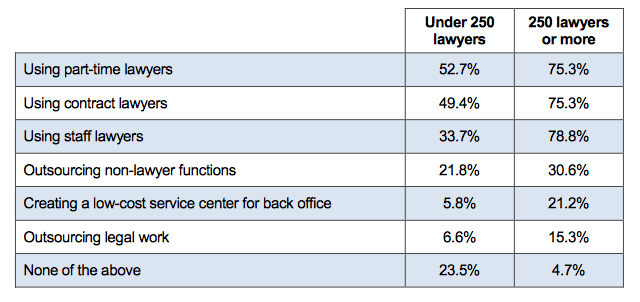Altman Weil’s recently released 2016 Law Firms in Transition survey is good reading for all law firm management. For me, the questions it raises are the number of non-partner track lawyers and who’s managing Big Law alternative staffing?
The survey found that a
“majority of firms are practicing basic labor arbitrage – shifting work to less costly lawyers. More than half of all law firms are utilizing part-time lawyers (59%) and contract lawyers (56%) to meet demand as needed. Three quarters of firms with 250 or more lawyers are using part-time and contract lawyers.”
A report table provides more detail:

Wide spread use of non-partner track lawyers in Big Law (beyond for document review) strikes me as relatively new. To confirm this impression, I reviewed past surveys. Altman Weil first asked this question in 2014. Answers from 2014 are roughly the same. Though the incidence has not changed, I think it says something this question first appeared only in 2014.
To understand what these data tell us, I compared staffing to another report finding:
“The only efficiency tactics that break the 50% mark among all law firms are knowledge management (54%) and use of technology tools to replace some human resources (52%). Techniques that really challenge the way work has been done traditionally, like legal project management or reengineering of work processes, are less likely to have been adopted, especially in smaller firms.” (Emphasis added.)
We see evidence of the rise of KM, LPM, and pricing in the growing numbers of Chief Knowledge Officers and Chief Practice Officers titles and in numerous events focused on these topics.
Alternative staffing, like KM and LPM, do not “really challenge the way work has been done traditionally“. On that basis, its high incidence is not surprising. But if alternative lawyer staff are as prevalent as the survey suggests, why don’t we see the rise of senior staff and events focusing on it? More fundamentally, who in Big Law decides how many the firm should have and how they are managed?
Earlier this year, I poked around the web and reached out to several contacts to explore this question. I only found a bit of information. My guess is that use of non-partner track lawyers is widespread but not deep. That is, many firms may have a handful, but few have big ranks of non-partner track lawyers or systematic programs.
Is my guess correct or am I missing something? If I’m not missing anything, then will we soon see increasing numbers of such lawyers and a more visible infrastructure to manage them?
Archives
Blog Categories
- Alternative Legal Provider (44)
- Artificial Intelligence (AI) (57)
- Bar Regulation (13)
- Best Practices (39)
- Big Data and Data Science (14)
- Blockchain (10)
- Bloomberg Biz of Law Summit – Live (6)
- Business Intelligence (21)
- Contract Management (21)
- Cool Legal Conferences (13)
- COVID-19 (11)
- Design (5)
- Do Less Law (40)
- eDiscovery and Litigation Support (165)
- Experience Management (12)
- Extranets (11)
- General (194)
- Innovation and Change Management (188)
- Interesting Technology (105)
- Knowledge Management (229)
- Law Department Management (20)
- Law Departments / Client Service (120)
- Law Factory v. Bet the Farm (30)
- Law Firm Service Delivery (128)
- Law Firm Staffing (27)
- Law Libraries (6)
- Legal market survey featured (6)
- Legal Process Improvement (27)
- Legal Project Management (26)
- Legal Secretaries – Their Future (17)
- Legal Tech Start-Ups (18)
- Litigation Finance (5)
- Low Cost Law Firm Centers (22)
- Management and Technology (179)
- Notices re this Blog (10)
- Online Legal Services (64)
- Outsourcing (141)
- Personal Productivity (40)
- Roundup (58)
- Structure of Legal Business (2)
- Supplier News (13)
- Visual Intelligence (14)
